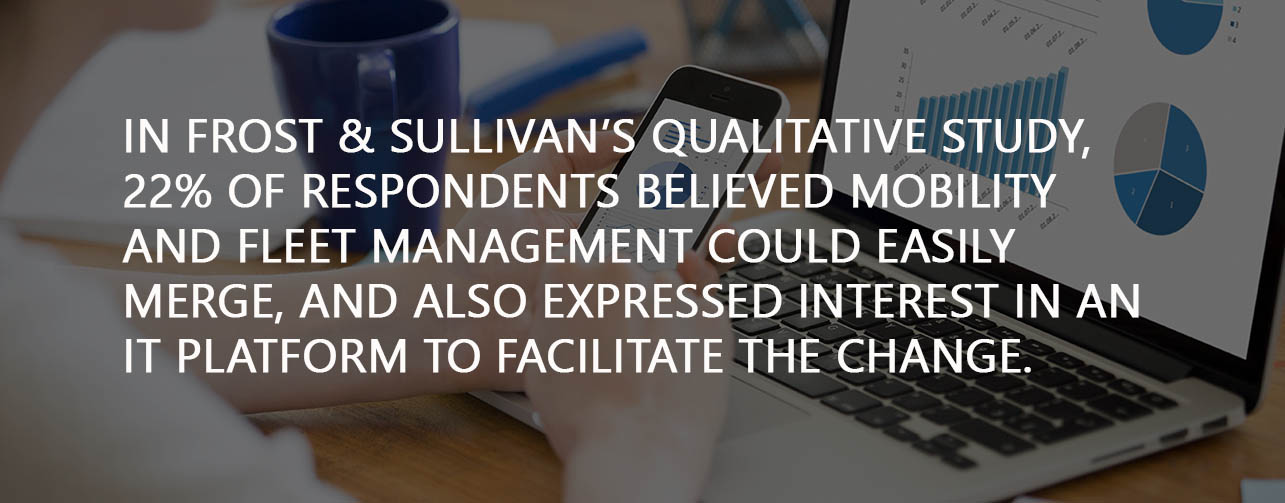Learning Zone
What is mobility management?
Mobility Management Uncovered
Using software to effectively address the mobility of people is predicted to be a big part of fleet management’s future …but what exactly does it mean?

For obvious reasons, we tend to think of fleet management in terms of managing the life cycle of a vehicle, while that traditional approach remains essential, today’s information and management technology is making it more and more possible to effectively manage the mobility of people, too.
Much like vehicles and equipment, staff members are mobile assets and – similarly to company fleet vehicles – through the use of ‘big data’, there are considerable savings to be made when it comes to managing how they get from A to B.
To help you understand the meaning of mobility management and the role it’s likely to play in the coming years, we have compiled a short guide.
Mobility management – what does it mean?
Mobility management, the fleet industry’s new buzzword, refers to the mobility of team members within an organization – more specifically for business purposes – and associated management techniques.
Typically, it is about extending traditional fleet management practices by integrating employee-related ‘big data’ – such as time, location and work behaviors – into daily operations, in order to pinpoint additional cost savings and enhance efficiency opportunities in regarding to how they travel.
In today’s fast-paced society, it’s important to stay in control of employee mobility and the associated costs so, as a first step, make sure you’re able to answer the following questions:
- How much does it currently cost each, individual employee to travel to their target destination?
- How often do they travel, and for what purpose?
- How is each journey made?
- Would an alternative mode of transport be viable?
It might sound simple, but by ensuring that you have an overview of all company travel requirements, you will be able to:
- Create a more economical, streamlined travel options
- Control and reduce spend
- Reduce the organization’s carbon footprint emissions
- Increase employee satisfaction
With this in mind, it’s important to recognize that change is coming – be clear on what you want, and make sure you have the ability to adapt as the industry evolves.
What are the alternative travel options?
First things first, mobility management isn’t implying you get rid of all your company vehicles and everyone ride the bus.
But it has become increasingly apparent that owning a vehicle is not always the most appropriate or cost-effective solution with regards to day-to-day business travel, so it’s important that you have the means to thoroughly evaluate other alternatives.
A company car can still provide the best solution, as it transports an employee door-to-door in a reasonable amount of time …but have you checked there isn’t another option that provides the same flexibility and productivity, at a lower cost?
If not, the answer might be right under your nose…
Consider the following alternative means to the company car:
- Travel allowances for personal vehicle use
- Corporate vehicle pools and pool cars
- Short term rentals
- Public transport solutions (train, bus etc..)
- New-age private hire companies, such as Uber and Lyft
More recently, the emergence of mobility cards – a travel option that has already been deployed in a select number of companies across the UK and continental Europe – has given fleet managers something else to think about…
Employees with mobility cards are allocated a monthly travel budget, which presents them with the freedom to choose their preferred means of travel. Also working as a financial incentive, employees are invited to keep the remaining balance at the end of each month which, in turn, works to increase employee satisfaction whilst encouraging more sustainable travel choices.
To be clear, this step-change cannot be generalized across all fleet vehicles within your business, for example logistics and blue light vehicles are unlikely to require change – as they service a function beyond simply the transport of personnel.
The benefits of managing employee mobility
The ability to effectively manage the mobility of people is increasingly an essential part of any corporation’s fleet management tool kit.
By applying the principles of Total Cost of Ownership (TCO) in a system that also measures the Total Cost of Mobility (TCM), it is possible to create a more economical; efficient; streamlined and cost-effective operation …and the benefits of mobility management are clear.
It allows you to:
- Know the true cost of employee travel – by evaluating and identifying the most cost-effective mode of transport
- Calculate exact transport budgets, and provide spending controls that lead to better bottom line performance
- Improve the utilization of work forces by incorporating mobility-related data
- Improve operational efficiency
- Enhance employee satisfaction
Software solutions:
Not all that long ago, accessing mobility options could prove time consuming and difficult, however, today many of those alternatives are more readily available, either via web-based solutions or mobile applications.
Using software to track and manage the mobility of employees has also improved, and new capabilities developed in recent years now make it simpler to manage flexible, corporate travel arrangements.
In short, it helps you to understand what’s best for your business by considering which time and cost variables provide the most effective means of meeting your company needs …and there are several ways in which these tools can be applied to streamline the mobility such mobility.
It allows you to:
- Effectively manage all forms of travel, including company issued vehicles, pool vehicles, personal cars, rentals and a range of public transportation options
- Introduce mobility cards, which provide employees with a travel budget that can be used for a variety of transportation services
- Compare travel options, in real time, to develop corporate mobility policies that lower cost without impacting efficiency or productivity
- Track and manage accounts with external transportation providers
- Improve visibility into driver information to ensure compliance with regulations and corporate rules
- Keep driver records organized and up-to-date so that all the information you need is available when company or personal vehicles are in use
- View information in a single dashboard where you can include details of vehicle usage and other types of travel expenses
- Develop reports on mobility solutions to find the most cost effective and efficient alternatives
Conclusion
The mobility management of people for business purposes is about making more intelligent transportation choices based on an understanding of both business needs and the preferences of people.
It’s possible that parts of the industry will a move away from traditional vehicle ownership, focusing instead on mobility, however, for this movement to be successful, employees will need to accept the change and evolve simultaneously – they will play perhaps the most critical role in that sense.
As the industry progresses, mobility is likely to become an integral part of the overall fleet management equation, leading to better management decisions with regards to the use and acquisition of all types of fleet and corporate assets, including the people charged with conducting your everyday business.



